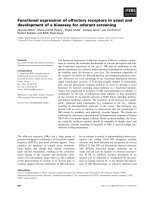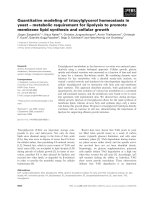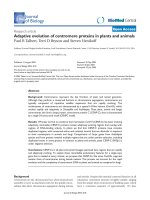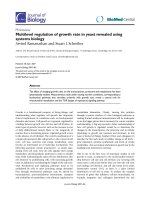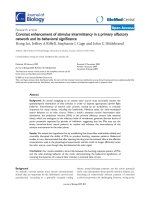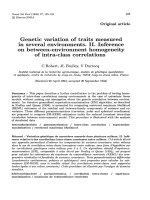Báo cáo sinh học: "Multilevel regulation of growth rate in yeast revealed using systems biology" pptx
Bạn đang xem bản rút gọn của tài liệu. Xem và tải ngay bản đầy đủ của tài liệu tại đây (136.12 KB, 5 trang )
Minireview
Multilevel regulation of growth rate in yeast revealed using
systems biology
Arvind Ramanathan and Stuart L Schreiber
Address: The Broad Institute of Harvard & MIT, Chemical Biology Program, 7 Cambridge Center, Cambridge, MA 02142, USA.
Correspondence: Stuart L Schreiber. Email:
Growth is a fundamental property of living things, and
understanding what regulates cell growth has important
clinical implications in conditions such as developmental
disorders and cancer. Cell growth is, in general, regulated by
a linkage between growth rate, cell size and cell division. In
some types of growth, however, such as the increase in size
of fully differentiated muscle fibers or the outgrowth of
neurites from a developing neuron, regulated growth occurs
in the absence of cell division. The overall coordination of a
complex phenomenon like cell growth, in the context of cell
cycle, cell size, nutrients and energy metabolism, must
involve an interrelated set of molecular mechanisms. The
following questions remain unanswered - at steady state,
during every cell cycle, how do cells regulate their energy
metabolism and biosynthetic pathways in order to double
mass while maintaining the same cell size distribution after
cell division? In proliferating cells, with increasing growth
rates, in addition to coordinating the length of the cell cycle,
what biochemical and signaling pathways need to be
modulated by cells to meet increasing energy demands?
Flux through biochemical pathways may be altered by
transcriptional, post-translational mechanisms, transport
and availability of metabolites, or by allosteric regulation by
metabolites themselves. Clearly, viewing this problem
through a narrow window of a few biological pathways or
making limited analytical measurements will be inadequate
to see the bigger picture that is necessary for a more complete
understanding. A big step towards a better understanding of
how cell growth is regulated would be to determine the
changes in the transcriptome, the proteome and in cellular
physiology as growth rate increases and decreases. In this
issue of Journal of Biology, Stephen Oliver and colleagues [1]
describe the first such study of cellular change at all levels -
gene expression, proteins synthesized, and levels of certain
metabolites - that accompany alterations in growth rate in the
budding yeast Sacharomyces cerevisiae.
This is one of the first wave of systematic studies of cell
growth in yeast, as opposed to the much-studied relation-
ship between cell size and cell division [2]. Growing cells
must reach a critical size before they can enter the cell cycle
and undergo cell division, and cell size seems to be under
homeostatic control [3-6], as there is a quite limited
distribution of cell size in yeast. To analyze the complex
network of genes that influence cell-size homeostasis, for
example, Jorgensen and colleagues determined the size
Abstract
The effect of changing growth rates on the transcriptome, proteome and metabolome has been
systematically studied. Measurements made under varying nutrient conditions, corresponding to
biochemical pathways that correlate primarily with growth rate, reveal a central role for
mitochondrial metabolism and the TOR (target of rapamycin) signaling pathway.
BioMed Central
Journal of Biology 2007, 6:3
Published: 30 April 2007
Journal of Biology 2007, 6:3
The electronic version of this article is the complete one and can be
found online at />© 2007 BioMed Central Ltd
distributions of a complete set of yeast deletion strains [2].
They uncovered a dynamic relationship, dependent on the
transcription factor Sfp1, between signals that stimulate
ribosomal biogenesis and the critical size threshold before
cell division.
Growth rate has seldom been studied so systematically.
Most transcriptional profiling and systems biology studies
in yeast have been performed in batch culture where the
nutrient conditions and growth rates are continuously
changing. It is therefore difficult to separate the primary
effect of changing growth rates on cellular physiology from
secondary nutritional and environmental effects. This
problem can be avoided by carrying out experiments in
continuous culture using a chemostat and limiting nutrients
[7-9]. The doubling time (T
d
) of a culture is inversely related
to the growth rate (µ) by the expression (T
d
= ln2/µ). In a
continuous culture at steady state, the dilution rate (D,
defined by the ratio of the rate of addition of the nutrient
medium and the volume of the culture) is equal to the
growth rate. Therefore, changing the dilution rate can
control the growth rate in a continuous culture.
Using this experimental approach, Regenberg et al. [10]
recently carried out whole-genome transcriptional profiling
on continuous cultures of S. cerevisiae to uncover the impact
of changing growth rates on the transcriptional program in
a model eukaryotic cell. With glucose as the limiting
nutrient, continuous cultures were grown at six specific
growth rates with doubling times ranging from 2 to 35 hours.
Using consensus clustering methods [11], the authors
analyzed 5,930 yeast transcripts and observed that the levels
of half the transcripts changed as growth rate increased.
Transcripts of proteins involved in biogenesis, such as
amino-acid and lipid biosynthesis, ribosomal protein
biosynthesis, nucleotide metabolism, and respiration, were
upregulated as a function of growth rate. Transcripts present
at higher levels at slower growth rates correlated strongly
with those known to be present in cells under stress [12],
indicating that common signaling pathways may regulate
both cell stress and slow growth rates.
An important observation in this study was the relationship
between carbon metabolism and growth rate. At high D
(greater than 0.3/hour), yeast cells switch their metabolism
from pure respiration to a mix of fermentation and
respiration. This phenomenon of simultaneous respiration
and fermentation is known as the Crabtree effect after the
physiologist H.G. Crabtree, who showed that tumor cells
under aerobic conditions have lower rates of respiration
after the addition of glucose [13,14]. In his 1929 paper
Crabtree stated, “the glycolytic activity of tumors exerts a
checking effect on their respiration” [13]. These results
followed the closely related observations by Otto Warburg
on increased aerobic glycolysis compared to respiration in
tumors [15]. In their study, Regenberg et al. [10] found that
in conjunction with this metabolic switch at high growth
rates, there were abrupt changes in the levels of some yeast
transcripts, with increases in expression of key genes involved
in glucose transport and vesicle transport and repression of
those involved in ethanol metabolism and gluconeogenesis.
The metabolic shift from oxidative to fermentative growth
has also been investigated using
13
C flux analysis by Frick et
al. [16], who studied three different growth rates in
continuous culture. They found that this shift was
accompanied by a change in carbon flux from the pentose
phosphate pathway towards glycolysis, a decrease in flux
through the tricarboxylic acid (TCA) cycle, and an increase
through pyruvate carboxylase and ethanol production.
Despite the insights gained from these studies, we lack a
systems-level understanding of eukaryotic growth-rate
control. The experiments carried out so far have been
mostly confined to transcriptional analysis; there is, how-
ever, strong evidence for the importance of translational
and post-translational control of eukaryotic growth [17,18].
To uncover these effects requires comprehensive analysis of
the impact of growth rate at the level of transcripts, proteins,
and metabolites. In addition, carrying out separate
experiments with ammonium, phosphate or sulfate as
limiting nutrients, and not just glucose, would help to
further differentiate purely growth-related effects from
nutrient-related effects.
In this issue Castrillo et al. [1] now describe such a compre-
hensive study of eukaryotic growth-rate control. They used
continuous cultures of S. cerevisiae to measure the impact of
the change in growth rate on the transcriptome, proteome
and metabolome under four different nutrient-limiting
conditions - glucose, ammonium, phosphate, and sulfate. It
is useful to visualize the details of the experiment in the
form of a matrix, as shown in Figure 1. This experimental
design is able to separate out the control of cell growth rate
in terms of gene expression, protein levels, and metabolic
flux. To reveal components related to growth-rate regula-
tion, Castrillo et al. [1] looked for changes common to all
four nutrient-limiting conditions.
A striking insight from their study is that all three global
measurements revealed growth-rate correlated trends,
suggesting a multilevel (transcriptome, proteome, and meta-
bolome) control of growth rate. Initially, they examined
changes in transcript levels correlating with increasing
growth rates using analysis of covariance (ANCOVA) after a
multiple testing correction. They found 493 transcripts that
were upregulated and 398 that were downregulated with
3.2 Journal of Biology 2007, Volume 6, Article 3 Ramanathan and Schreiber />Journal of Biology 2007, 6:3
increasing growth rates in all four nutrient-limiting
conditions. Transcripts that were up- and downregulated
with growth rate were similar to those found in the study by
Regenberg et al. [10]. Castrillo et al. also observed up-
regulation of stress-responsive genes with lower growth
rates. In this study, transcription of genes involved in
autophagy, a response to starvation, was shown to increase
with decreasing growth rates. Genes involved in autophagy
are highly conserved from yeast to mammals, and the
autophagic response to starvation is mediated by the target
of rapamycin (TOR), a protein kinase that is important in
the control of eukaryotic cell growth [19]. Further
emphasizing the importance of TOR in growth-rate control,
the study found that 72.5% of growth-rate-regulated genes
were also responsive to rapamycin, which inhibits the TOR
complex 1 (TORC1) signaling pathway.
Castrillo et al. [1] extended their study to the level of the
proteome, using isotope tags for multiplexed relative and
absolute quantifications (iTRAQ) to measure levels of
particular proteins at two growth rates. The transcriptional
and proteomic profiling were performed on samples from
the same culture, and after sample normalization and
statistical treatment, the datasets could be analyzed for
correlation between the levels of proteins and their mRNAs.
The paper introduces a useful metric to measure mechanisms
of control at the level of RNA or protein, called ‘trans-
lational control efficiency’, which is defined by the ratio of
the level of a protein to that of its RNA. For each nutrient
condition, the authors found that 35% of transcripts have
significant changes in translational control efficiency,
indicating post-transcriptional or post-translational control
mechanisms. Integrating these datasets with metabolite
measurements is more difficult, and for this study Castrillo
et al. integrated levels of a selected subset of important
metabolites with the transcriptome data [20].
One of their key findings is that within a metabolic path-
way, such as the biosynthesis of leucine, both
transcriptional and translational control may be operating,
with only a subset of enzymes being regulated at the protein
level. They also looked at the metabolite S-adenosyl-
methionine (SAM) and inferred a role for SAM metabolism
in growth-rate regulation from the fact that the level of the
metabolite itself changes with growth rate, along with an
increase in the levels of the Sam2 S-adenosylmethionine
synthase (but not of Sam1) and of other enzymes involved
in SAM biosynthesis. An increasing level of SAM with
increased growth rate was accompanied by upregulation of
rRNA and tRNA methyltransferases. Thus, Castrillo et al. [1]
were able to specifically implicate Sam2 as mediating the
flux of S-adenosylmethionine towards RNA methylation.
The efficient regulation of flux between carbon and nitrogen
in amino-acid biosynthesis can be analyzed by measuring
the levels of key metabolic intermediates and relevant
proteins. Castrillo et al. [1] found that with increasing
growth rates, transcription of the gene encoding the TCA
cycle enzyme cis-aconitase increased, and levels of its
Journal of Biology 2007, Volume 6, Article 3 Ramanathan and Schreiber 3.3
Journal of Biology 2007, 6:3
Figure 1
The experimental approach used by Castrillo et al. [1]. The regulation
of eukaryotic growth is described in the form of a matrix, with growth
rates, nutrient-limiting conditions, and cell measurements as the three
axes. Yeast continuous cultures were grown at three growth rates
under four different nutrient limiting conditions (glucose, ammonium,
sulfate and phosphate). Transcriptome, proteome and metabolome
measurements were made for each member of this matrix. Changes
that correlated with growth rate under all four nutrient-limiting
conditions were attributed to intrinsic growth-related processes.
Relative changes in transcriptome, proteome, and a few key metabolite
measurements were correlated to identify biological pathways that play
a critical role in growth-rate regulation.
Growth rate (per hour)
Nutrient-
limiting
condition
Transcriptional profiling
Glucose
Ammonium
Phosphate
Sulfate
0.07
0.1
0.2
Proteomic profiling
Metabolomic profiling
Measuring global impact of changing growth rates
Analysis of Covariance for discovering changes that
correlate with growth rate under all four nutrient
limiting conditions
• Proteome-Transcriptome dataset
correlation
• Case by case integration of key
metabolite changes
• Examining functions and biological
pathways using gene annotations
Cell
measurements
substrate, citric acid, decreased. Similarly, increased levels of
the TCA cycle enzyme succinate dehydrogenase were accom-
panied by a corresponding decrease in succinate. From these
observations, an increased flux though the TCA cycle could
be inferred. 2-Oxoglutarate, an intermediate in the TCA
cycle, is critical in coupling carbon metabolism to nitrogen
metabolism via glutamate dehydrogenase and glutamine
synthase. It is interesting to note that in spite of the inferred
increased flux through the TCA cycle, steady-state
metabolite levels of both 2-oxoglutarate and glutamine did
not change, and there was a decrease in levels of glutamate.
Instead, there was a corresponding trend in the increase in
the transcript and protein levels of the mitochondrial
2-oxoglutarate transporters, and an increase in protein
levels of glutamine synthase, further corroborating the
coupling between carbon and nitrogen metabolism with
increasing growth rates.
This study is one of the first to provide evidence of a
comprehensive set of biochemical pathways that are
regulated at the transcript, protein and metabolite level. In
addition to making important strides in the application of
analytical technologies for global measurements, the
authors use these measurements to gain insights into the
importance of mitochondrial energy and nitrogen metabo-
lism in affecting growth rates. These insights were possible
only by integrating information from transcripts, protein
levels and relevant mitochondrial metabolites, and could
not have been obtained from any one of these aspects
alone. Pathways central to mitochondrial and nitrogen
metabolism are regulated by TOR-mediated signaling [21],
and metabolite levels that change with growth rate, like
glutamate, are known to modulate the mTOR pathway [22].
Therefore, an important trend that emerges from this study
is to direct future research towards a more detailed study of
the effect of TOR signaling in the regulation of growth rate.
Finally, this work also addresses important challenges for
the integration of metabolomic data with proteomic and
transcriptional datasets. Castrillo et al. [1] integrate the
metabolome data on an ad hoc basis in an empirical
fashion; for example, levels of metabolites involved in the
TCA cycle were related to levels of transcripts and enzymes
that connect to them as substrates or products. The
difficulty in a systematic analysis of many metabolites arises
from the fact that there is not necessarily a simple one-to-
one relationship between metabolites and a given protein
or transcript. Some metabolites (such as ATP) can be
connected with a very large number of pathways, as they are
substrates or products of a number of different biochemical
reactions. Furthermore, when measuring steady-state
metabolite levels it can be difficult to interpret flux through
the pathway without additional measurements, such as
glucose or oxygen consumption rates, or by using isotope-
labeled substrates. Systematic data integration has been
attempted for a small number of metabolites such as glucose
or ethanol, where using a partial least square method a matrix
of metabolite measurements was modeled as a function of a
matrix of transcriptional measurements. Using this
mathematical approach, a set of genes that corresponded to
changes in metabolite data was discovered [20].
The work of Castrillo et al. [1] essentially varied the growth
rate and identified its systemic impact. The next stage will
be to study the impact on growth rate of altering gene copy
numbers or transcript levels, which will provide further
enlightenment on the complex multilevel regulation of
eukaryotic growth rate.
References
1. Castrillo JI, Zeef LA, Hoyle DC, Zhang N, Hayes A, Gardner
DCJ, Cornell MJ, Petty J, Hakes L, Wardleworth L, Rash M,
Brown M, Dunn WB, Broadhurst D, O’Donoghue K, Hester SS,
Dunkley TPJ, Hart SR, Swainston N, Li P, Gaskell SM, Paton
NW, Lilley KS, Kell DB, Oliver SG: A comprehensive
systems-biology study of growth control in yeast. J Biol
2007, 6:4.
2. Jorgensen P, Nishikawa JL, Breitkreutz BJ, Tyers M: Systematic
identification of pathways that couple cell growth and divi-
sion in yeast. Science 2002, 297:395-400.
3. Hartwell LH, Culotti J, Pringle JR, Reid BJ: Genetic control of
the cell division cycle in yeast. Science 1974, 183:46-51.
4. Cross FR: Starting the cell cycle: what’s the point? Curr Opin
Cell Biol 1995, 7:790-797.
5. Johnston GC, Pringle JR, Hartwell LH: Coordination of growth
with cell division in the yeast Saccharomyces cerevisiae. Exp
Cell Res 1977, 105:79-98.
6. Jorgensen P, Tyers M: How cells coordinate growth and divi-
sion. Curr Biol 2004, 14:R1014-R1027.
7. Hayes A, Zhang N, Wu J, Butler PR, Hauser NC, Hoheisel JD, Lim
FL, Sharrocks AD, Oliver SG: Hybridization array technology
coupled with chemostat culture: Tools to interrogate
gene expression in Saccharomyces cerevisiae. Methods 2002,
26:281-290.
8. Wu J, Zhang N, Hayes A, Panoutsopoulou K, Oliver SG: Global
analysis of nutrient control of gene expression in Saccha-
romyces cerevisiae during growth and starvation. Proc Natl
Acad Sci USA 2004, 101:3148-3153.
9. Boer VM, de Winde JH, Pronk JT, Piper MD: The genome-wide
transcriptional responses of Saccharomyces cerevisiae
grown on glucose in aerobic chemostat cultures limited
for carbon, nitrogen, phosphorus, or sulfur. J Biol Chem 2003,
278:3265-3274.
10. Regenberg B, Grotkjaer T, Winther O, Fausboll A, Akesson M,
Bro C, Hansen LK, Brunak S, Nielsen J: Growth-rate regulated
genes have profound impact on interpretation of tran-
scriptome profiling in Saccharomyces cerevisiae. Genome Biol
2006, 7:R107.
11. Grotkjaer T, Winther O, Regenberg B, Nielsen J, Hansen LK: Robust
multi-scale clustering of large DNA microarray datasets with
the consensus algorithm. Bioinformatics 2006, 22:58-67.
12. Gasch AP, Spellman PT, Kao CM, Carmel-Harel O, Eisen MB,
Storz G, Botstein D, Brown PO: Genomic expression pro-
grams in the response of yeast cells to environmental
changes. Mol Biol Cell 2000, 11:4241-4257.
13. Crabtree HG: Observations on the carbohydrate metabo-
lism of tumours. Biochem J 1929, 23:536-545.
14. Postma E, Verduyn C, Scheffers WA, Van Dijken JP: Enzymic
analysis of the crabtree effect in glucose-limited chemostat
3.4 Journal of Biology 2007, Volume 6, Article 3 Ramanathan and Schreiber />Journal of Biology 2007, 6:3
cultures of Saccharomyces cerevisiae. Appl Environ Microbiol
1989, 55:468-477.
15. Warburg O, Wind F, Negelein E: The metabolism of tumors
in the body. J Gen Physiol 1927, 8:519-530.
16. Frick O, Wittmann C: Characterization of the metabolic
shift between oxidative and fermentative growth in Sac-
charomyces cerevisiae by comparative
13
C flux analysis.
Microb Cell Fact 2005, 4:30.
17. De Virgilio C, Loewith R: Cell growth control: little eukary-
otes make big contributions. Oncogene 2006, 25:6392-6415.
18. Mata J, Marguerat S, Bahler J: Post-transcriptional control of
gene expression: a genome-wide perspective. Trends
Biochem Sci 2005, 30:506-514.
19. Kamada Y, Sekito T, Ohsumi Y: Autophagy in yeast: a TOR-
mediated response to nutrient starvation. Curr Top Microbiol
Immunol 2004, 279:73-84.
20. Pir P, Kirdar B, Hayes A, Onsan ZY, Ulgen KO, Oliver SG: Inte-
grative investigation of metabolic and transcriptomic
data. BMC Bioinformatics 2006, 7:203.
21. Kuruvilla SG, Shamji AF, Schreiber SL: Carbon- and nitrogen-
quality signaling to translation are mediated by distinct
GATA-type transcription factors. Proc Natl Acad Sci USA 2001,
98:7283-7288.
22. Crespo JL, Powers T, Fowler B, Hall MN: The TOR-controlled
transcription activators GLN3, RTG1, and RTG3 are regu-
lated in response to intracellular levels of glutamine. Proc
Natl Acad Sci USA 2002, 99:6784-6789.
Journal of Biology 2007, Volume 6, Article 3 Ramanathan and Schreiber 3.5
Journal of Biology 2007, 6:3
